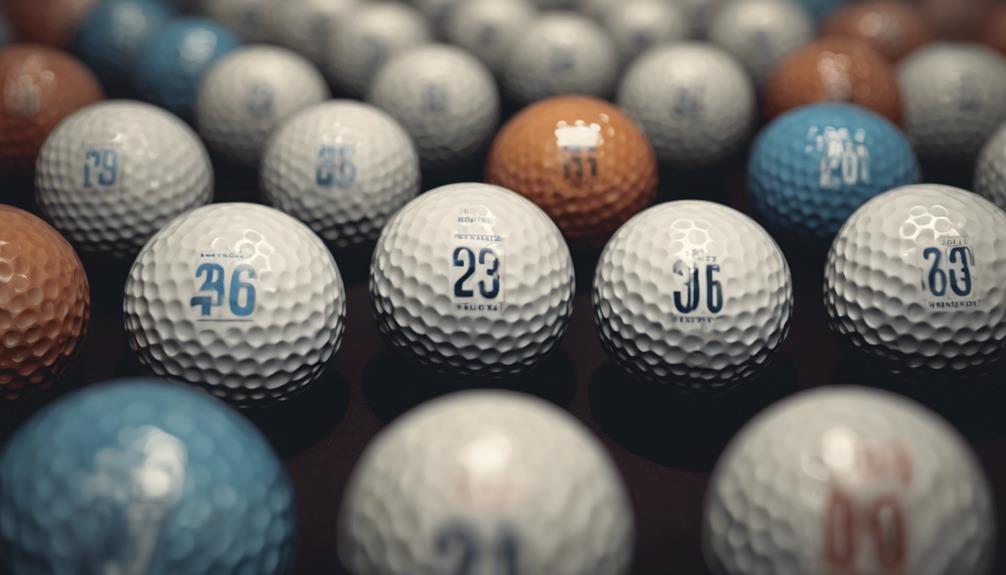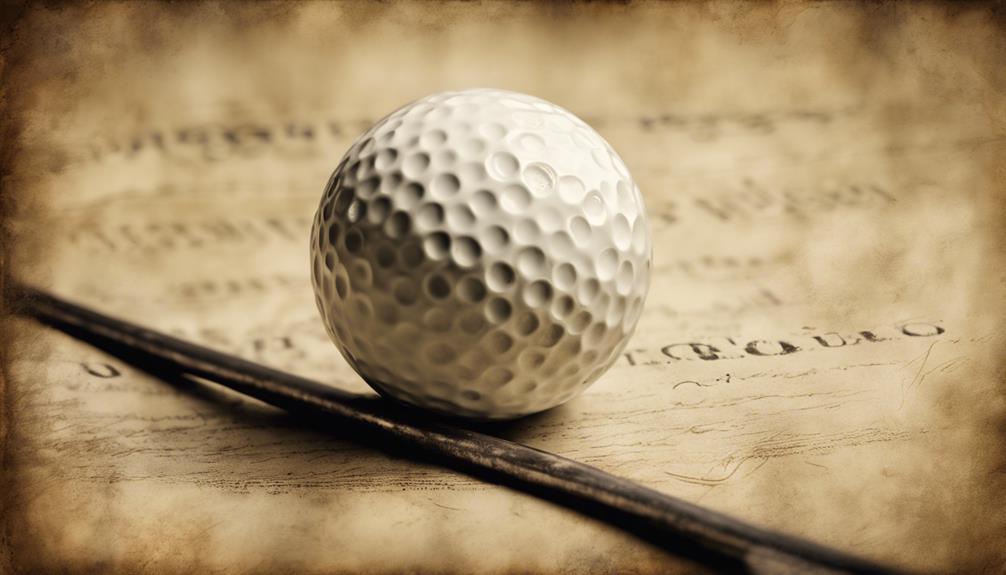- 7 Top Flite Golf Clubs XL for Improved Performance - September 28, 2024
- Top Flite Golf Clubs: Top 5 Reasons to Choose Them - September 28, 2024
- Top 3 Golf Club Fitters for a Perfect Swing - September 28, 2024
You've likely noticed that golf balls often feature various numbers, and these numbers are more than just decorative – they provide valuable information about the ball's performance and identity. Single-digit numbers help distinguish balls during play, while two-digit numbers indicate compression ratings affecting swing speed suitability. Three-digit numbers may represent the number of dimples on the ball, impacting flight stability and distance. Whether you're a pro or a beginner, understanding these numbers is essential for optimizing your game, and as you explore further, you'll uncover the subtleties that can make all the difference on the course.
Key Takeaways
- Golf balls typically have numbers, which serve as unique identifiers, indicate compression ratings, or represent the number of dimples on the ball.
- Single-digit numbers (1-4) help distinguish balls during play and can be customized with personal markings for further differentiation.
- Two-digit numbers (70-110) indicate compression ratings, affecting ball responsiveness and suitability for different swing speeds.
- Three-digit numbers usually indicate the count of dimples (300-500), which enhance flight stability and distance for better performance.
Understanding Golf Ball Numbers
As you examine a golf ball, you'll likely notice a series of numbers etched onto its surface, each serving a distinct purpose that can greatly impact your game.
These numbers, categorized into single-digit, two-digit, and three-digit numbers, hold the key to revealing your ball's performance and identity. Golf ball manufacturers strategically place these numbers to provide essential information.
Single-digit numbers, ranging from 1 to 4, help you distinguish your ball from others during play.
Two-digit numbers, on the other hand, indicate the compression rating of the ball, which affects its suitability for different swing speeds. A lower compression rating means a softer ball, while a higher rating means a firmer one.
Although less common, three-digit numbers may represent the number of dimples on the ball, influencing its flight stability and distance.
Single-Digit Identification
As you examine your golf ball, you'll notice a single-digit number below the brand name – what's the significance of this number, and how does it help you identify your ball on the course?
You'll find that this number serves as a unique identifier, setting your ball apart from others.
It's especially useful when playing with friends who use the same brand.
Number Significance
You'll often notice that golf balls feature a single-digit number, usually between 1 and 4 but sometimes up to 9, printed below the brand name or logo, serving as a unique identifier to help you distinguish your ball from others during play.
This single-digit number isn't just a random selection; it's an intentional design choice meant to personalize your ball. For instance, if you're playing with the Titleist Pro V1x, you might notice that the number is printed in red, while the Pro V1 has a black number stamped on it.
These different colors can indicate specific models, making it easier to identify your ball.
It's important to remember that this number isn't a requirement, and you can personalize your balls further with additional markings to prevent confusion among players using the same brand and model.
Don't worry if you lose a ball or need to switch during a game – there's no rule that mandates using the same numbered ball throughout.
Brand Differentiation
Brand differentiation through single-digit identification plays an essential role in distinguishing your golf ball from others, especially when multiple players are using the same brand and model during a game.
You might notice that numbers printed below the brand name on your golf ball range from 1 to 4, or in some cases, up to 9. This single-digit number serves primarily for player identification and differentiation during play.
The color of the number, usually black or red, doesn't hold any specific meaning beyond identification. However, different models of the same brand may be indicated by varying colors of the single-digit numbers, helping you distinguish between them.
To further customize their balls, some players use unique personal markings in addition to the single-digit number. This way, you can easily identify your golf ball even when it's mixed up with others.
Two-Digit Compression Ratings

As you explore two-digit compression ratings on golf balls, you'll want to understand the scale that measures the ball's responsiveness to your swing speed.
You'll find that compression ratings, ranging from 70 to 110, directly impact energy transfer, which affects the distance and control of your shots.
Compression Rating Scale
To better understand the performance of a golf ball, it's vital to grasp the compression rating scale, which typically falls between 30 and 100, with lower ratings indicating softer balls.
You'll find that lower compression golf balls, typically ranging from 70 to 80, are ideal for juniors and seniors, as they provide better feel and control for players with less power.
On the other hand, high compression balls, close to 100, are better suited for stronger players seeking maximum distance.
It's important to note that compression ratings impact the energy transfer from the club to the ball, and a well-matched compression can enhance your distance and overall performance.
Notably, some manufacturers, like Titleist golf balls, have phased out indicating compression ratings on their golf balls, focusing instead on other features and technologies to attract players.
Energy Transfer Impact
When you take a swing, the compression rating of your golf ball plays an essential role in determining how much energy is transferred from the club to the ball, directly impacting the distance and accuracy of your shot.
A ball's compression rating affects how much it deforms upon impact, and this deformation has a significant influence on the energy transfer.
If you're looking for more control and feel, a softer ball with a lower compression rating (70-80) might be the way to go. On the other hand, if you're a power player, a higher compression rating (90-100) can help you achieve greater distance.
TP5 golf balls, for instance, have a higher compression rating, making them suitable for players with faster swing speeds.
When you're about to purchase golf balls, understanding the balls' compression rating is vital. It helps you choose the right ball for your swing characteristics, ensuring you get the most out of your game.
Three-Digit Dimple Counts
You'll often find three-digit numbers emblazoned on golf balls, but what do these numbers represent? Typically, these numbers indicate the count of dimples on the golf ball, ranging from 300 to 500.
Dimples play a vital role in enhancing a golf ball's flight stability and distance, making them essential for peak performance. For instance, the Titleist Pro V1x from the mid-2000s featured a specific count of 332 dimples, highlighting the emphasis on aerodynamic design.
Smooth-surfaced golf balls can only fly half the distance of dimpled balls, underlining the importance of the dimple count in ball performance.
Curiously, the inclusion of dimple counts in three-digit numbers has decreased in modern designs as manufacturers have shifted focus to other performance attributes.
Customization and Markings

Golfers are taking their game to the next level by personalizing their balls with unique markings, making them instantly recognizable on the course.
You're not just limited to the standard numbers on golf balls; you can add custom markings to make your ball stand out. With a permanent marker, you can create your own unique designs or add meaningful numbers to commemorate special occasions. This not only adds a personal touch but also helps you identify your ball during play, reducing the risk of mix-ups with your playing partners.
Many golfers use sharpies, stickers, or stamps to add custom markings to their balls. Some manufacturers even offer customization options for double-digit numbers, allowing you to personalize your ball with significant dates or achievements.
Whether you're playing with friends or in a tournament, custom markings can give you an edge and make your game more enjoyable. By adding your own personal touch to your golf ball, you'll be able to identify it quickly and focus on your game.
Avoiding Ball Confusion
To avoid confusion on the course, it's important to make sure your ball stands out from the rest, especially when multiple players are using the same brand and model. You can do this by taking advantage of the identification numbers and personal markings available on golf balls.
Here are three ways to avoid ball confusion:
- Choose a unique identification number: While standard golf balls typically feature single-digit numbers (1-4), you can opt for customization options that offer double-digit numbers (00-99) for enhanced personal identification.
- Add personal markings: Initials, symbols, or other personal markings can be added to your ball to further differentiate it from others. This is especially helpful when playing with friends or in group tournaments.
Historical Context of Numbers

In the early days of golf ball manufacturing, numbers on balls served a practical purpose, specifically indicating compression ratings that ranged from 70 to 110 and catered to various swing types. These ratings influenced your purchasing decisions, as you chose a ball that suited your swing style.
Manufacturers initially used color coding, like red for lower compression, but this practice has since lost significance. The stigma surrounding low-compression balls, often marketed as 'ladies' balls', also impacted consumer perceptions and brand reputation.
The game-changing shift from wound to solid-core golf balls revolutionized the industry, leading to a change in how numbers were utilized on golf balls. As the market evolved, the importance of compression ratings in marketing decreased. You'll notice that many modern balls omit this information altogether.
This historical context is essential in understanding the role of numbers on golf equipment today. By grasping how manufacturers adapted to market evolution, you'll better appreciate the complexity of golf balls and the factors that drive their design.
Ball Performance Characteristics
As you examine a golf ball, you'll notice several numerical indicators that reveal valuable insights into its performance characteristics, including the number of dimples, compression rating, and identification number. These numbers are more than just labels – they affect how the ball behaves on the course.
Here are three key performance characteristics influenced by these numerical indicators:
- Aerodynamics and stability: The number of dimples notably impacts how the ball flies, with an optimized pattern enhancing lift and reducing drag for increased distance.
- Swing speed compatibility: Compression ratings determine how the ball reacts to different swing speeds, making it essential to choose a ball that suits your playing style.
Understanding the relationship between these numerical indicators and ball performance characteristics is vital for optimizing your game. By recognizing how these factors interact, you can select the best golf ball for your playing style and course conditions, giving you a competitive edge.
Selecting the Right Golf Ball

You're now faced with the essential decision of selecting the right golf ball, and it's important to take into account the numerical indicators that can make a significant difference in your game.
When choosing a golf ball, consider the compression rating indicated by two-digit numbers. If you have a lighter swing, look for lower ratings (70-80), while more powerful swings require higher ratings (90-100).
The single-digit identification number on the ball helps differentiate it from others during play, typically ranging from 1 to 4. Understanding the three-digit number, which often indicates the dimple count (typically between 300-500), can inform your choice based on desired golf ball performance and distance.
Matching the right golf ball to your swing speed is essential, as softer, low-compression balls are generally more suitable for juniors and seniors, while harder balls are better for faster swings.
Frequently Asked Questions
What Are the Numbers on Golf Balls?
When you pick up a golf ball, you'll notice numbers on it – these indicate golf ball types, affecting ball performance, distance control, and spin rate, with some numbers even signifying color variations, helping you master your game.
What Does 1/2 3/4 Mean on Golf Balls?
'Imagine your golf ball is a secret code, and the numbers 1/2 or 3/4 are the clues to revealing your game. These mysterious markings likely represent personal customizations, not standard golf ball design, distance performance, ball compression, spin rate, or player preference indicators.'
What Do Numbers on Balls Mean?
When you examine the numbers on your golf ball, you're uncovering clues to its performance, branding significance, and even color variations, which can impact distance control and reflect your personal player preferences.
How Do You Identify Golf Balls?
You identify golf balls by recognizing brand logos, color schemes, and unique markings, as well as distinguishing features like material differences, performance indicators, and specific golf ball types, ensuring you're playing with the right one on the course.
Conclusion
As you line up your shot, you've likely noticed the numbers on your golf ball. It's no coincidence that these numbers have a purpose. They identify your ball, indicating compression rating, dimple count, and even customization.
But what do they really mean? Understanding these numbers can help you choose the right ball for your game, and maybe, just maybe, improve your score.
Coincidence? Perhaps, but knowing your ball's numbers is a step in the right direction.




